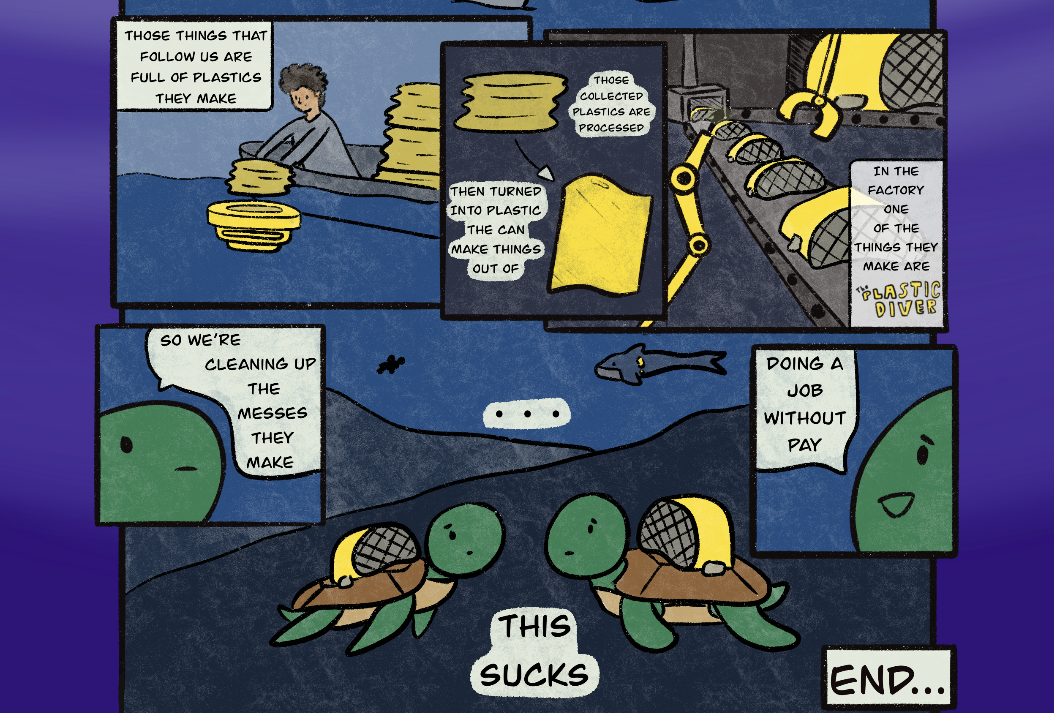Leah Pistorius
April 28, 2021
Through visual storytelling, UW students explore more-than-human concepts, human relationships with other species and the natural world, and future scenarios of collaborative survival.
As the pandemic swept through 2020 and people rapidly adjusted to new norms, HCDE student Michael Beach began wondering what life will look like on the other side. "I am immunocompromised, and I started thinking, how am I going to make it back on campus? Am I going to need to be in some kind of elaborate bubble? I started seeing these contemporary hazmat-style helmet designs for everyday living and was fascinated thinking about these concepts that explore what it means to be human, and how these designs could extend to care for non-human species as well," Beach described.
 In the zine Breakout, Kyler Menge looks at tensions between fungus and humans, fungus and plants, and plants and humans. Menge asks, should humans use fungus if it kills other organisms? At what point are humans and fungus considered a single organism?
In the zine Breakout, Kyler Menge looks at tensions between fungus and humans, fungus and plants, and plants and humans. Menge asks, should humans use fungus if it kills other organisms? At what point are humans and fungus considered a single organism?
A third-year PhD student in the Department of Human Centered Design & Engineering, Beach researches how more-than-human perspectives can update design methods and theories, especially those commonly used in computing fields, to enhance the way we approach problems.
"In HCDE, we are designing things for people. And it's important that we maintain our focus on equity and justice, but that we expand that work to non-humans as well," said Beach. To do so, Beach believes we need to expand the human-centered design process by including methods and tools from other fields, such as feminist science (fiction) studies, process philosophy, and post-humanism. "Incorporating these more-than-human concepts and theories in the design process helps us ask new questions," said Beach. "And for the big, wicked problems we face — things like climate collapse — I wonder if we can address these problems with the same methods and tools that we've been using so far, or if we need new ones."
In autumn quarter, Beach designed and led a Directed Research Group (with support from Tyler Fox, an assistant teaching professor in HCDE) for UW undergraduates and master's students to explore concepts of post-humanism and collaborative survival in a cataclysmic climate future. Throughout the quarter, the students developed more-than-human value scenarios in the form of comic strips and curated the narratives into a final zine. "We chose to focus on a zine, which is a kind of creative, science fiction artifact, because there isn't a ton of work out there that translate these relatively new 3rd wave theories into practice,” said Beach. “Storytelling is a good way to work with these concepts and put them into value scenarios that we can explore and reflect upon."
 In The Plastic Diver, Ryan Bautista explores the relationship humans have with the underwater environment and ethics around designs for cleaning human-made pollution.
In The Plastic Diver, Ryan Bautista explores the relationship humans have with the underwater environment and ethics around designs for cleaning human-made pollution.
The group began by discussing the concept of hazmat, or literally hazardous materials. "We brainstormed what's needed in a hazmat suit for human-made hazards, as well as natural hazards like erupting volcanoes," Beach described. "We dove into the hazmat concept and started talking about hazmat as protection from something. We brainstormed concepts such as 'protections from anxiety' and 'protections from capitalism.' From there, we did design activities to begin to visualize these concepts."
Throughout the course, assigned readings looked at various methods such as value-sensitive design, speculative design, discursive design, critical design, and multispecies ethnography. In each meeting, the students would discuss a theory introduced in the readings and do a design activity to get comfortable incorporating the theory into practice.
 In Connected: Visualization of Forest Web, Jiayi Tang explores the cooperative, interdependent relationships in the forest. When humans bring in wearable technologies, they can help trees in danger. But at the expense of who or what?
In Connected: Visualization of Forest Web, Jiayi Tang explores the cooperative, interdependent relationships in the forest. When humans bring in wearable technologies, they can help trees in danger. But at the expense of who or what?
Staying with the Trouble, a book by Donna Haraway, provided guidance and inspiration to the group. Beach advised students away from being techno-centric and solution-oriented and instead encouraged them to ask questions about who or what is being designed for, and who or what is not being designed for. "If we don't ask these questions, then it's really easy to come up with solutions. Your stakeholders or your funders may get exactly what they want. But who is left? Who is marginalized? And that's the importance of 'staying with the trouble,'" said Beach. "Through the workshop activities and critique, students would help one another identify pain points and uncover new tensions in their designs for the next iteration."
At the end of the quarter, the students presented their stories from the zine and process work in a course showcase for the HCDE community. "These are really creative stories, and we hope that they will encourage readers to think differently about the types of effects and relations we are entangled in with non-humans, the nonliving, and the natural world," said Beach. ■
View the zine at michaelwbeach.com/posthumanhazmat and below.